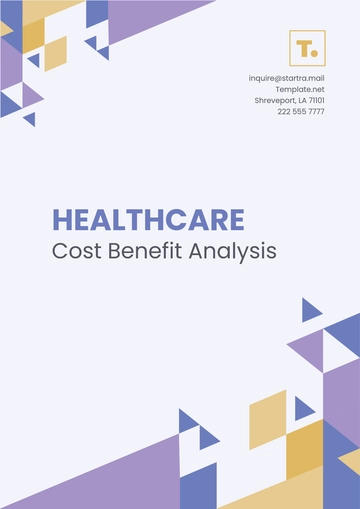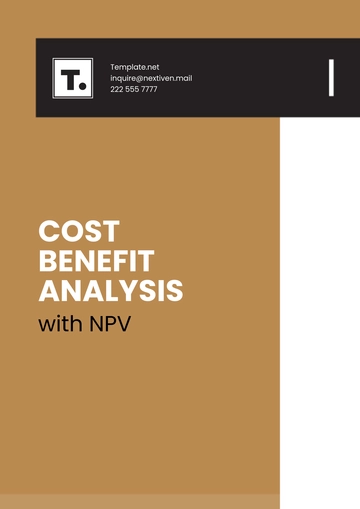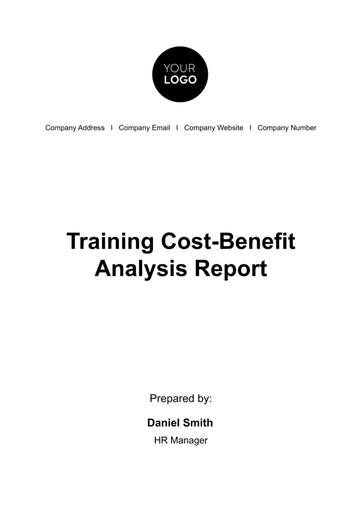Free Workplace Safety Financial Analysis

1. Executive Summary:
Workplace safety is a paramount concern for our organization, [Your Company Name], as it directly affects the well-being of our employees and the overall financial stability of our company. This Workplace Safety Financial Analysis delves into the crucial financial aspects linked to our robust Health and Safety Policy.
Ensuring a safe work environment is not just a moral obligation but also a strategic imperative. By safeguarding our employees, we reduce the financial burden associated with workplace incidents, ultimately bolstering our bottom line.
Over the past year, our commitment to safety has translated into tangible results. Notably, our investments in employee training, safety equipment, regular safety audits, and state-of-the-art safety software have positioned us as an industry leader in workplace safety compliance. This proactive approach has not only mitigated the risk of costly incidents but has also improved our productivity and enhanced our reputation.
This report will provide an in-depth analysis of the financial implications of our Health and Safety Policy, covering the cost of workplace incidents, compliance expenditures, return on safety investments, and the substantial cost savings realized through our commitment to safety. By the end of this analysis, you will gain a comprehensive understanding of how our dedication to workplace safety has not only protected our employees but also positively impacted our company's financial well-being.
2. Percentage and Cost of Workplace Incidents:
Workplace safety is a fundamental aspect of [Your Company Name]'s operations, driven by practical considerations rather than rhetoric. Our commitment to safety is deeply rooted in our understanding of the direct and indirect financial implications associated with workplace incidents. This Workplace Safety Financial Analysis aims to provide a clear-cut overview of the financial aspects linked to our company's Health and Safety Policy.
Workplace incidents have concrete financial consequences for our organization. The following chart and table quantify the financial impact of incidents in the past year:
Category | Cost (in $000.00) |
Medical Expenses: | [$500.00] |
Workers' Compensation: | [$000.00] |
Property Damage: | [$000.00] |
Legal Fees: | [$000.00] |
Lost Productivity: | [$000.00] |
Total Incident Costs: | [$000.00] |
The chart and table break down the various cost categories stemming from workplace incidents. Medical expenses cover the costs of medical treatments for injured employees, while workers' compensation addresses financial support provided to employees unable to work due to injuries. Property damage accounts for any damage to company assets, while legal fees reflect the costs incurred during legal proceedings resulting from incidents. Lost productivity quantifies the value of work time lost due to accidents, and the total incident costs provide a comprehensive financial perspective on these incidents.
In the subsequent sections of this report, we will delve into these financial aspects further, including strategies for cost reduction and ROI on safety investments.
3. Cost of Compliance:
Ensuring strict adherence to safety regulations is imperative to safeguard our employees and maintain operational integrity. This section provides a detailed breakdown of the financial investments made in ensuring compliance with safety standards.
The following table presents a comprehensive view of our compliance costs, including specific financial data:
Compliance Category | Cost (in $000.00) |
Employee Training: | $150.00 |
Safety Equipment: | [$000.00] |
Safety Audits: | [$000.00] |
Safety Software: | [$000.00] |
Total Compliance Costs: | [$000.00] |
Employee Training ($150,000): This category includes expenses related to training programs designed to educate our workforce on safety protocols and procedures. It encompasses training materials, instructor fees, and any associated travel or accommodation costs.
Safety Equipment ($00,000): To ensure the safety of our employees, we invest in high-quality safety equipment, such as personal protective gear, safety signage, and emergency response tools. This category covers the procurement, maintenance, and replacement of these essential safety assets.
Safety Audits ($00,000): Regular safety audits are conducted to identify and rectify potential hazards in our workplace. This cost includes fees for external audit services, as well as internal resources dedicated to audit preparations and implementation of corrective actions.
Safety Software ($00,000): We employ state-of-the-art safety software to streamline safety reporting, incident tracking, and compliance monitoring. This investment ensures efficient management of safety-related data and processes.
The Total Compliance Costs represent the cumulative financial commitment required to adhere to safety regulations and maintain a secure work environment. It is essential to note that these investments contribute significantly to risk mitigation and employee well-being.
In the subsequent sections of this report, we will assess the return on these compliance investments and their impact on our overall financial performance.
4. ROI on Safety Investments:
Assessing the return on investment (ROI) for our safety initiatives is essential to gauge the financial advantages derived from our commitment to a safe workplace. This section focuses on the quantifiable benefits resulting from our safety investments.
The following table presents a comprehensive view of the ROI on safety investments, including specific financial data:
ROI Category | Amount (in $000.00) |
Reduced Incidents | [$500.00] |
Improved Productivity | [5%] |
Insurance Premium Savings | [$000.00] |
Reputation Enhancement | Positive impact |
Total Benefits | $000.00 |
Reduced Incidents ($500,000): By proactively implementing safety measures and training programs, we have prevented a significant number of workplace incidents. This reduction in incidents directly translates into cost savings associated with medical expenses, workers' compensation, property damage, legal fees, and lost productivity.
Improved Productivity (5%): Our commitment to safety has led to a 5% increase in overall productivity. This boost in productivity is a result of fewer work stoppages due to accidents, as well as increased employee morale and engagement.
Insurance Premium Savings ($000,000): Our exemplary safety record has led to reduced insurance premiums. By demonstrating a lower risk profile to insurers, we have realized substantial cost savings in insurance premiums.
Reputation Enhancement (Positive impact): While challenging to quantify precisely, our strong commitment to safety has enhanced our reputation within the industry. This has potential long-term benefits, such as attracting top talent and fostering trust among clients and partners.
The Total Benefits represent the cumulative financial gains achieved through our safety investments. These benefits not only mitigate the costs associated with workplace incidents but also contribute positively to our company's overall financial performance.
5. Cost Savings from Health and Safety Policy:
Our steadfast commitment to the Health and Safety Policy has yielded substantial cost savings for [Your Company Name]. This section provides a comprehensive overview of the financial benefits resulting from the effective implementation of our policy.
The following table presents a detailed breakdown of the cost savings derived from our Health and Safety Policy, including specific financial data:
Savings Category | Amount Saved (in $000.00) |
Reduced Incidents | [$1,200.00] |
Insurance Premium Reduction | [$000.00] |
Workers' Compensation Savings | [$000.00] |
Legal Fees Avoided | [$000.00] |
Total Cost Savings | [$000.00] |
Reduced Incidents ($1,200,000): By prioritizing safety, we have significantly reduced workplace incidents. This reduction has directly translated into cost savings by lowering medical expenses, workers' compensation payouts, property damage costs, legal fees, and lost productivity.
Insurance Premium Reduction ($000,000): Our commitment to safety and the resulting decrease in incidents have led to a substantial reduction in insurance premiums. This directly contributes to our financial savings.
Workers' Compensation Savings ($000,000): Fewer workplace incidents have reduced the need for workers' compensation payouts, resulting in significant cost savings in this category.
Legal Fees Avoided ($000,000): Our proactive safety measures have prevented legal issues and disputes, resulting in avoided legal fees and associated costs.
The Total Cost Savings represent the sum of all these categories and demonstrate the overall financial benefit derived from our Health and Safety Policy. These savings not only bolster our financial stability but also underscore the effectiveness of our commitment to workplace safety.
6. Total Workplace Safety Expenditure:
This section presents a comprehensive financial overview that combines both the costs and savings associated with our workplace safety initiatives. By calculating the total workplace safety expenditure, we gain a clear understanding of the financial impact of our commitment to safety.
The following table provides a breakdown of the total workplace safety expenditure, including specific financial data:
Expenditure Category | Amount (in $000.00) |
Total Cost of Workplace Incidents | [$2,750.00] |
Total Compliance Costs | [$000.00] |
Net Benefits from Safety Investments | [$000.00] |
Total Cost Savings | [$000.00] |
Net Workplace Safety Expenditure | [$000.00] |
Total Cost of Workplace Incidents ($0,000,000): This category comprises the direct and indirect costs incurred due to workplace incidents, encompassing medical expenses, workers' compensation, property damage, legal fees, and lost productivity.
Total Compliance Costs ($000,000): This includes all expenditures related to ensuring compliance with safety regulations, covering employee training, safety equipment, safety audits, and safety software.
Net Benefits from Safety Investments ($000,000): These benefits arise from reduced incidents, improved productivity, insurance premium savings, and reputation enhancement resulting from our safety investments.
Total Cost Savings ($0,000,000): The cumulative financial gains from reduced incidents, insurance premium reduction, workers' compensation savings, and avoided legal fees.
The Net Workplace Safety Expenditure is the final calculation that represents the difference between the total costs and the total savings. This figure provides a clear picture of the net financial impact of our workplace safety initiatives.
This comprehensive financial analysis underscores the significance of our commitment to workplace safety not only in protecting our employees but also in contributing positively to our company's overall financial well-being.
7. Conclusion:
Our commitment to workplace safety not only ensures the well-being of our employees but also has a positive impact on our financial performance. The financial analysis presented here underscores the importance of maintaining a strong Health and Safety Policy.
- 100% Customizable, free editor
- Access 1 Million+ Templates, photo’s & graphics
- Download or share as a template
- Click and replace photos, graphics, text, backgrounds
- Resize, crop, AI write & more
- Access advanced editor
Maximize financial transparency and efficiency with Template.net's innovative Workplace Safety Financial Analysis Template. This editable tool empowers businesses to meticulously assess safety costs, compliance expenditures, and ROI on safety investments. Featuring intuitive tables and customizable placeholders, it simplifies data analysis, enabling informed decision-making to safeguard your bottom line. Strengthen your financial strategy with Template.net today.





























